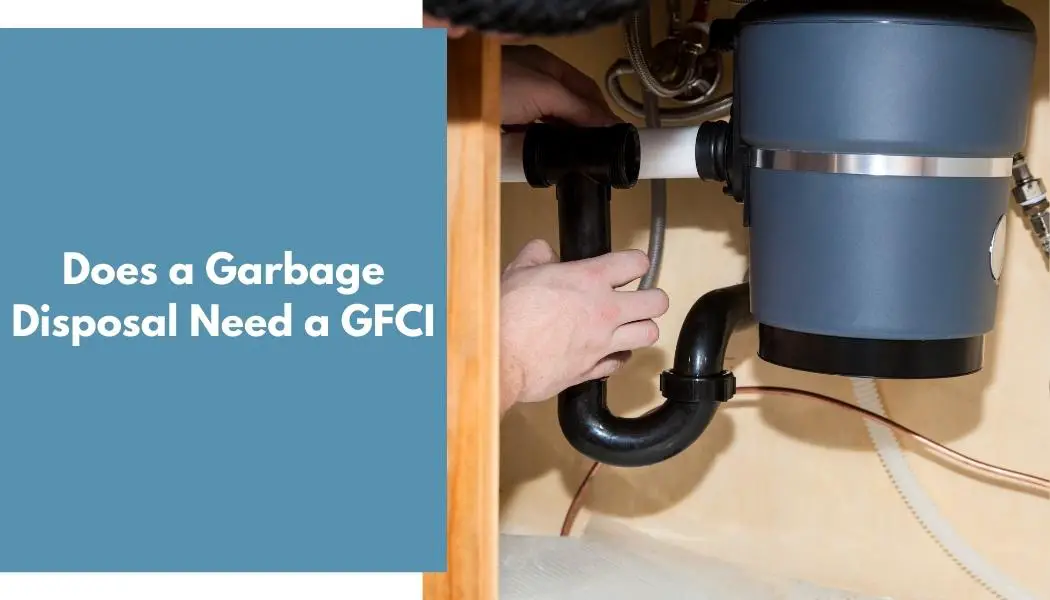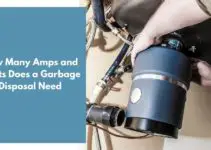If you’re reaching to turn on your garbage disposal while still wet, you might find yourself in a dilemma. Having a ground fault circuit interrupter (GFCI) is also helpful for keeping your disposal working properly.
Garbage disposal does not need a GCFI. However, it’s still a good idea to have one. Having one will protect you from getting shocked if an electrical issue occurs.
This article will teach you the importance of having one and ways to utilize it correctly.
Contents
What is GFCI?
A ground fault circuit interrupter, also directed to as GFCI, is a device that prevents an electric shock from happening to you if an electrical device in your home gets damaged.
The concept of this system is simple: It compares the current on the hotter side of the device to the output current on the other side. If the system detects that the current is leaking out, it indicates something is wrong with the device.
It cuts the power supply in less than 30 milliseconds to protect the user. This feature dramatically reduces the risk of electrocution.
This type of device is for areas where there’s a chance that a receptacle might get exposed to moisture. It can significantly decrease the risk of electrocution.
Areas that are commonly affected by ground fault circuit interrupters include bathrooms, kitchen cabinets, crawl spaces, laundry rooms, and utility areas.
Usually, ground fault circuit protection is at the outlet or the distribution panel. However, this feature is always with a circuit breaker.
Is GFCI Necessary for a Garbage Disposal Unit?
It is unnecessary, but to prevent electrical damage, it’s ideal having a ground fault circuit interrupter (GFCI). It is because disposal units are usually near a water source.
A ground fault circuit interrupter is an instrument that prevents electrocution. It senses the presence of this electrical issue and stops the power supply to the affected circuits when it feels an electric shock.
These outlets are present in areas where water might accidentally enter a power circuit, leading to fires and electrocution. They can also prevent fires in laundry rooms and kitchens.
Homeowners should install ground fault circuit interrupters in areas 6 feet from a sink and a power outlet. Garbage disposal units should also be present underneath the sink.
Although not required, a garbage disposal should also have ground fault circuit interrupters. You should install this device in areas near a water source like a sink.
You may not be able to thoroughly rule out the possibility of accidentally turning on the power switch while cooking, so it is still essential to have these devices to protect yourself from electrocution and fire danger.
You should also install these devices in areas where water might enter a power circuit. For instance, outlets used as countertops should also have GFCI protection.
How to Install a Ground Fault Circuit Interrupter?
If you plan to install a ground fault circuit interrupter, you first need to install an electric box underneath the sink. This box should be within reach of the disposal unit’s power cord. After securing the cable, run it through a metallic conduit.
Before tinkering with the device, make sure that the power is still off. If it still isn’t, turn it off and follow the procedure.
- To separate the wires, take out the sheath and draw 10 inches of cable out of the box.
- Then, remove the plastic cover of the wires. If you plan to connect the device to a power outlet, ensure that the ground fault circuit interrupter connects to the outlet.
- After securing the wires, wrap the remaining wire around the ground screw. Place the outlet in place, and you should cover its plate.
Although it is important to have ground fault circuit interrupters in place, you can still trip them at any time. For instance, if your garbage disposal machine gets tripped due to external moisture or a leak, it could cause a fire.
The GFCI will trip if the water inside the device touches the part of the wiring that carries electricity. However, since this wire is usually covered, most GFCI accidents are rare.
You should also regularly inspect your garbage disposal to ensure that the tank and the wires are not leaking.
Prices pulled from the Amazon Product Advertising API on:
Product prices and availability are accurate as of the date/time indicated and are subject to change. Any price and availability information displayed on [relevant Amazon Site(s), as applicable] at the time of purchase will apply to the purchase of this product.
What Are Some Electrical Requirements for Installing a Garbage Disposal?
According to an organization that represents home inspectors, there are a few other things that you should consider when it comes to garbage disposal installation.
One of the most common reasons people have difficulty getting their garbage disposal to turn on is the vibration. It can cause the electrical connections in the box to come loose. Having a good look at the package will also help identify the cause of the issue.
You should connect your garbage disposal to an outlet that’s leveled to a grounded electrical current. You can also use a dedicated circuit, though it’s usually better to share it with the dishwasher.
Frequently Asked Questions
Does a Garbage Disposal Unit Need a Dedicated Circuit?
A garbage disposal unit should have a dedicated circuit to chop down food waste efficiently. You should connect this feature to a 12V or 15A circuit. If it’s close to a water source, it should connect to a 120V circuit.
In most cases, garbage disposal and a washing machine are duos you need to acknowledge. However, I would typically advise connecting the two to a 20amp power circuit. Typically, the garbage disposal uses around four to eight amps, while the washing machine uses about three.
What Happens if a Garbage Disposal Unit Doesn’t Have a GFCI?
A garbage disposal unit near water might not work if it doesn’t have a ground fault circuit interrupter. However, it will work fine if the power source install correctly and the water is not in contact.
You might consider installing a ground fault circuit interrupter (GFCI) if the garbage disposal is near water. However, you might not need to install it if it’s far away from water sources, such as the sink. Your chances of getting electrocuted are minimal.
Where Is GFCI for Garbage Disposal?
It is important to note that the ground fault circuit interrupter (GFCI) location will vary depending on the installation. One should always look for the component near the sink where the garbage disposal is present.
It will be near the sink’s base or the cabinet below it in most cases. If you’re unsure where to find the ground fault circuit interrupter, you might want to consult an electrician.
Why Does My Garbage Disposal Trip the GFCI Outlet?
The garbage disposal might trip the ground fault circuit interrupter (GFCI). This issue occurs when the receptacle connected to the removal feeds from the load side of the circuit interrupter. You might also need to call an electrician to fix this.
How to Wire a GFCI Outlet for a Garbage Disposal?
If you have a garbage disposal, you don’t need a ground fault circuit interrupter (GFC) if it’s the only appliance plugged into the outlet. However, if you’re also using other devices, you’ll need to wire them to a GFC.
After you have shifted off the power to your circuit breaker, you can then remove the cover plate from its outlet. You can also remove the old outlet from its electrical box.
To secure the wires, twist the black wire around the black plug on the side of the outlet. Then, turn and pull the white wire around the silver pin on the other side. Finally, plug the GFCI into place.
Conclusion
Generally speaking, a garbage disposal does not need a GFCI. Garbage disposal is a helpful household appliance that helps reduce the amount of waste you can dispose of.
Installing a ground fault circuit interrupter (GFC) is recommended to prevent electrocution. It is because water can potentially contact the outlets serving the disposal.







